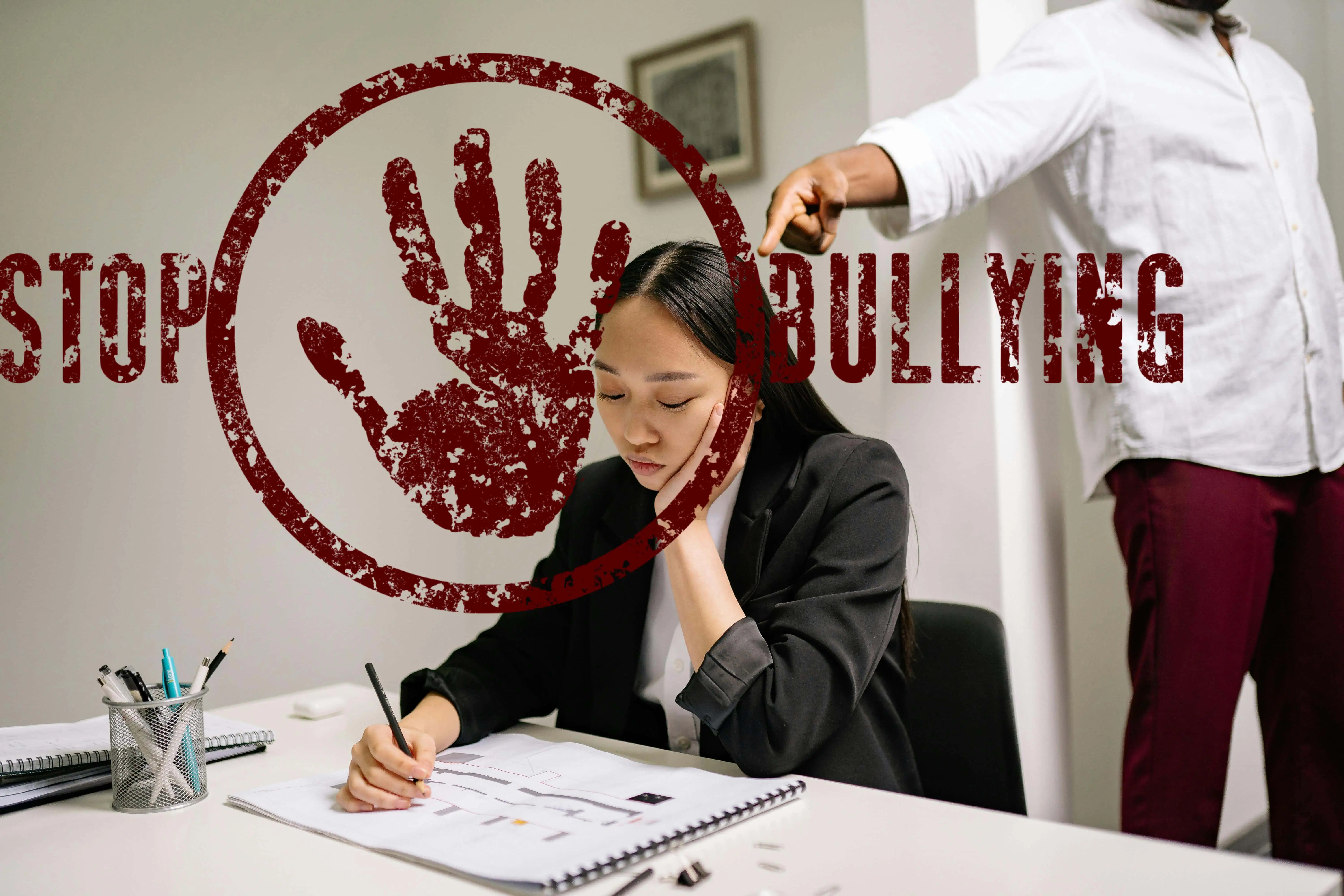Welcome to our comprehensive guide on understanding and combating workplace bullying. Whether entering the workforce for the first time or seeking to promote a healthier environment, this guide is designed to equip you with the necessary knowledge and tools.
Why is addressing workplace bullying important?
Workplace bullying is not just a personal issue—it affects organizational climate and productivity. Recognizing the signs and impacts of bullying can help create a more supportive and inclusive work atmosphere. This guide breaks down the signs, effects, legal aspects, and strategies for dealing with workplace bullying.
Learn how to identify, respond to, and prevent workplace bullying. Together, we can ensure a safe and positive workplace for everyone.
Understanding Workplace Bullying
Workplace bullying involves repeated, health-harming mistreatment of one or more persons by one or more perpetrators. It is a pattern of behavior that can include verbal abuse, offensive conduct, and efforts to sabotage a worker’s performance. Recognizing these behaviors is the first step toward addressing and stopping them.
Common Forms of Bullying
- Verbal Abuse: This includes shouting, mocking, or using sarcastic and demeaning language.
- Exclusion: Deliberately excluding someone from meetings, conversations, or workplace activities they should be part of.
- Sabotage: Interfering with someone’s ability to work, like withholding needed information.
Subtle Signs of Bullying
- Excessive Monitoring: Repeatedly checking up on someone without justification can create a hostile environment.
- Unfair Criticism: Consistent unfair remarks or disapproval aimed at creating self-doubt.
- Manipulation of Work Role: Changing someone’s job role or duties to their detriment without a valid reason.
Understanding these behaviors is crucial for both employees and managers. Employees can better protect themselves and seek help, while managers can recognize early signs and intervene. Establishing an inclusive workplace culture can also prevent these behaviors from taking root. For further reading, OSHA provides guidelines on identifying and dealing with workplace bullying. Stay informed, stay empowered, and help create a respectful workplace for everyone.
Signs of Workplace Bullying
Identifying workplace bullying can be challenging due to its subtle nature. Awareness of the signs can help individuals and organizations address the issue proactively. Here are some indicators to watch for:
Behavioral Signs
- Isolation: Victims may be socially isolated by bullies and noticeably left out of team interactions.
- Decreased Performance: Victims often show a decline in job performance due to stress and anxiety caused by bullying.
Physical and Emotional Signs
- Stress and Anxiety: Continuous bullying can lead to physical symptoms like headaches and high blood pressure.
- Low Morale: This can manifest as low self-esteem, loss of motivation, or a dread of going to work.
Understanding these signs is critical, but so is taking action. Employees experiencing these issues should consider informing their HR department or seeking external resources and advice, such as those provided by the U.S. Equal Employment Opportunity Commission (EEOC). This proactive step can protect the individual and contribute to a healthier work environment.
Impacts of Workplace Bullying on Individuals
Workplace bullying can have profound effects on an individual’s life beyond just their time at work. Recognizing these impacts is vital for understanding the seriousness of workplace bullying.
Professional Consequences
- Job Loss: Victims may leave their jobs to escape bullying, affecting their careers and finances.
- Reduced Productivity: Constant stress can decrease efficiency and focus, hindering work output.
Personal and Psychological Effects
- Mental Health Issues: Prolonged exposure to bullying can lead to depression, anxiety, and even PTSD.
- Physical Health Decline: Stress from bullying often results in sleep disturbances, fatigue, and immune system disorders.
Moreover, studies by the American Psychological Association show long-term psychological trauma from persistent workplace bullying. Addressing workplace bullying supports victims and promotes a healthier, more productive work environment.
Creating an Inclusive Culture to Combat Workplace Bullying
An inclusive workplace culture prevents workplace bullying and boosts employee respect. Companies can implement strategies to build such an environment effectively.
Strategies for Building Inclusivity
- Diversity Training: Regular training sessions can raise awareness and reduce biases.
- Open Communication: Encouraging open dialogue helps employees feel valued and heard. This can deter potential bullies.
Benefits of an Inclusive Workplace
- Improved Employee Engagement: Inclusivity boosts morale and collaboration across the team.
- Reduced Conflict: Cultures that value diversity are less likely to experience bullying incidents.
Moreover, forming committees or task forces focusing on inclusivity can help maintain a bullying-free environment. These groups can work on initiatives that reinforce positive behavioral norms and equality. Ultimately, a proactive approach to inclusivity can drastically reduce workplace bullying, benefiting everyone in the organization.
Legal Rights and Resources for Victims
Victims of workplace bullying have several legal protections and resources at their disposal. Understanding these can empower individuals to stand up against unfair treatment.
Understanding Your Legal Rights
- Anti-Harassment Laws: Many regions have laws against harassment that cover bullying behaviors.
- Employment Policies: Employers often have internal policies that provide procedures for reporting bullying.
Seeking Help and Support
- Human Resources: HR departments are a crucial first step in formally addressing workplace bullying.
- Legal Counsel: Consulting with a lawyer can clarify your rights and potential actions.
For additional guidance, the EEOC offers resources on dealing with harassment and bullying at work. Armed with the right knowledge and resources, employees can confront workplace bullying more confidently and effectively.
Strategies for Responding to Workplace Bullying
Effective response strategies are essential for mitigating the effects of workplace bullying and ensuring it is addressed promptly.
Immediate Steps to Take
- Document Everything: Keep a detailed record of all incidents, including dates, times, and witnesses.
- Report the Behavior: Inform your supervisor or HR department about the bullying, using the documentation as evidence.
Long-Term Strategies
- Seek Support: To cope with the stress, consult with colleagues, a support group, or a mental health professional.
- Develop Coping Skills: Techniques such as stress management and assertiveness training can be beneficial.
Moreover, leadership plays a crucial role in addressing workplace bullying. They need to ensure a safe and supportive environment. Implementing clear policies and training can help prevent such behaviors. Additionally, check out Leadership and Responsibilities Toward Employees for more insight on leadership responsibilities. Through proactive and reactive measures, workplace bullying can be significantly reduced, creating a healthier work environment for all.
Leadership’s Role in Preventing Workplace Bullying
Leadership is crucial in setting the tone for workplace behavior and establishing a zero-tolerance policy against bullying.
Proactive Measures by Leadership
- Policy Implementation: Develop and enforce clear anti-bullying policies.
- Training Programs: Organize regular training to educate employees on recognizing and preventing bullying.
Supportive Actions
- Open Door Policy: Encourage employees to report bullying without fear of retaliation.
- Regular Check-Ins: Maintain communication with teams to gauge the work environment and address issues early.
Furthermore, leaders should model respectful behavior and ensure that all management levels adhere to the same standards. This commitment will help breed a respectful and safe workplace. With solid leadership, workplaces can become more resilient against the threats posed by workplace bullying.
Maintaining Mental Health in the Face of Workplace Bullying
Protecting mental health is essential when dealing with workplace bullying.
Immediate Coping Strategies
- Seek Professional Help: Counseling can provide tools to manage stress and emotional distress.
- Practice Self-Care: Engage in activities that promote relaxation and well-being, like exercise or meditation.
Building Long-Term Resilience
- Develop Emotional Intelligence: Enhance your ability to understand and manage emotions effectively.
- Strengthen Social Networks: Supportive relationships can provide comfort and advice during tough times.
Also, continuously educating oneself about workplace rights and mental health resources is crucial. For additional strategies to maintain mental wellness, explore Maintaining Mental Health in the Workplace. Ultimately, taking active steps to protect your mental health can mitigate the harmful effects of workplace bullying, supporting both personal and professional growth.
FAQs
What qualifies as workplace bullying?
Workplace bullying involves repeated, intentional behavior that harms an individual’s dignity, safety, or work environment. This can include verbal abuse, physical intimidation, and sabotage of work performance.
Can I be bullied by someone who is not my supervisor?
Yes, workplace bullying can occur between any members of an organization, including peers and even subordinates.
What should I do if I witness workplace bullying?
Report the incident to a supervisor or HR department. Supporting the victim by being a witness can also be crucial in addressing the situation.
Is workplace bullying illegal?
In many areas, specific laws cover workplace harassment and bullying, although legal definitions can vary. Always check local laws and regulations.
How can workplace bullying be prevented?
Organizations can prevent bullying by fostering an inclusive culture, providing training on workplace behavior, and implementing strict anti-bullying policies.
What are the long-term effects of workplace bullying on a company?
Long-term effects include decreased employee morale, higher turnover rates, and reduced productivity, which can also impact the company’s reputation.
Where can I find more resources on coping with workplace bullying?
Government health and labor websites, local support groups, and mental health professionals can provide resources and guidance on workplace bullying.
Conclusion
Workplace bullying is a serious issue that can profoundly affect individuals and disrupt workplace harmony. Understanding the signs, impacts, and strategies for managing such behaviors is vital to creating an inclusive and safe workplace. By breeding inclusive cultures and empowering individuals with knowledge of their rights and resources, we can create safer work environments for everyone.
Take Action
If you or someone you know is experiencing bullying, it’s essential to take action. Document the incidents, seek support, and utilize available resources to address the situation. Never hesitate to speak up.
Join Diversity Employment to find opportunities in companies that value a diverse and inclusive workplace. Choosing employers who prioritize diverse staffing jobs and these values builds a better work culture for everyone. Create change; start with where you work!




